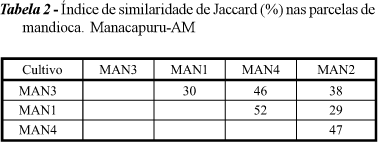This study aimed to evaluate seed density and number of species in a weed seed bank collected from four different cassava family farms. The farms were located on highway AM-070 in the state of Amazonas, Brazil. Four plots were established in each cassava crop, from which 20 15 x 15 cm samples.(0.0225 m²) at 0-5 cm depth level and three samples at 5-10 and 10-30 depth levels were collected, totalizing 104 samples. For seed counting and identification, plantlet emergence technique under greenhouse conditions was used. The plantlets were initially identified by morphotype and when possible, even by species. Monitoring was conducted during 9 months. A significant difference in seed density was found among the plots (Kruskal Wallis, 5%; p<0.05) and an average of 5.113 seeds m-2 at 0-5 cm depth. At the depth of 5-10 cm, the cassava crops presented an average of 1.111 seeds m-2 , while at the 10-30 cm depth,the average was 285 seeds m-2 . The seed banks of the cassava crops were basically herbaceous species typical of agricultural lands and disturbed environments. Weed cut once a year was not sufficient to control weed plants and reduce negative weed interference intensity. Thus, therefore, greater care is necessary during the periods before flowering and seed production, according to labor availability.
seeds in soil; herbaceous species; crop management; Manihot esculenta



